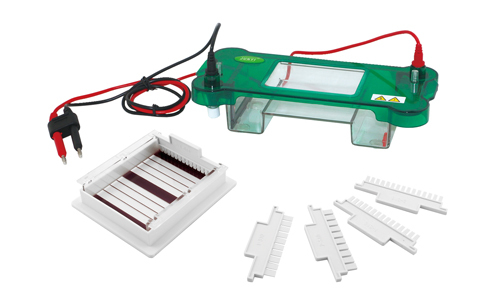Electrophoresis is a technique used in the laboratory to separate and purify molecules, usually proteins and nucleic acids. It is based on the mobility of ions in a wet medium subjected to an electrical gradient.
As can be seen, the steps required to perform electrophoresis are relatively simple to follow. Preparing the solution, preparing the stake, placing the sample, connecting the electrodes, feeding the electric field and collecting the products are the sequence of steps required to perform an electrophoresis properly. This is a useful technique to separate and purify different compounds for further analysis.
Steps required to prepare and perform electrophoresis
Step 1: Solution Preparation
The first thing that must be done to perform an electrophoresis is to prepare a solution containing the ions to be separated. This is usually done by adding a buffer suitable for the type of molecule being separated. The pH of the buffer must be adequate for the ions to separate properly in electric fields. In addition, the ion concentration must be adequate to ensure that the compounds separate as rapidly as desired.
Step 2: Preparation of the Stake
The stake is the vessel in which the sample will be placed to be subjected to electrophoresis. Depending on the type of electrophoresis to be performed, the stake can be made of glass, glass or a polymeric matrix such as a polyacrylamide gel or nylon membrane. The stakes are also prepared with suitable buffers to ensure proper electrophoresis performance.
Step 3: Sample Placement
Once the stake is ready one should proceed to deposit the sample inside. This procedure is often performed with automatic pipettes to help with accuracy. If array electrophoresis types are to be used, such as in electric fields, a small drop is deposited in the center corner of the array. If DC electrophoresis is involved, the sample is inserted at the bottom of the stake.
Step 4: Connect the Electrodes
Once the sample is deposited in the container, the electrodes are connected to the ends of the stake. The electrodes supply static amounts of electric current to generate the electric field between the two ends. These electrodes are usually made of coagulated polypropylene with a single layer to avoid current leakage.
Step 5: Powering the Electric Field
Finally, with the electrodes properly connected to the stake, an electrical circuit must be fed through them. The electric field generated by the current in the stake pulls the ions in the solution towards the ends. The ions are separated according to their size and charges. This can be done by an electrophoresis session or computer controlled.
Step 6: Product Collection
Once the concentration of ions at the poles is reached, the current is cut off and the products are collected from the ends of the stake. These products are soluble and can be diluted for further analysis and quantification.
What we offer you at Kalstein
We at Kalstein care about offering you the best equipment for electrophoresis, at the best price, and with excellent quality materials that cover the requirements demanded by microbiology laboratories, because we are manufacturers, we guarantee the follow-up of your purchase, and we accompany you before, during and after acquiring our equipment; know our electrophoresis equipment HERE.

